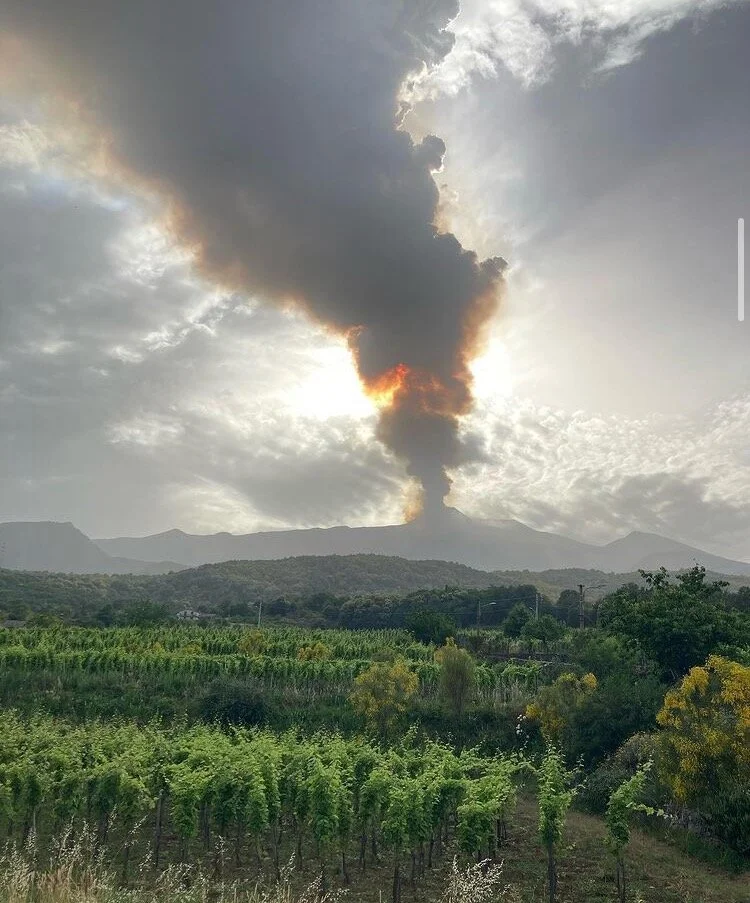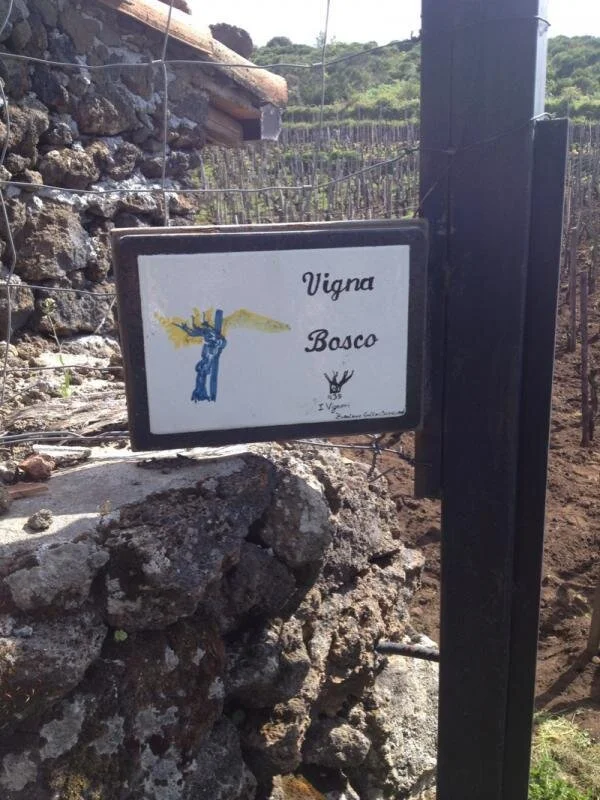I Vigneri di Salvo Foti - Mt Etna, Sicily
It is no use thinking you can see and behold Etna and the foreground both at once. Never. One or the other. Foreground and a transcribed Etna. Or Etna, pedestal of heaven. (dh lawrence, sea and sardinia)
Mount Etna is a stratovolcano on Sicily, a historic crossroads between Italy and Northern Africa. Its impact is felt in many mythologies and words for it exist in many ancient languages, revered and honored for its power that is capable of destroying towns (as it did Catania in 1669) and upending lives. Etna is a link to history and a reminder of the constant flux of the natural world. Geographically, Sicily is at similar latitudes to southern Italy but Etna reaches 11,000 feet. The elevation of vineyards on Etna is nearly alpine and allows for long hang time and maturation.
The wines of I Vigneri by Salvo Foti have Etna in them. They are a matter of personal curiosity to winemaker Salvo Foti who realizes that the only way to “see” Etna is to work Etna in the way it is traditionally worked. He was able to discover viticultural records about winemaking in the region that went into great depth about the work in the vines.
I Vigneri refers to the workers in the field and the name is pulled from a centuries-old union of Etna winegrowers who shared techniques. Foti found these teachings and applied them to his work in the present day, after a career where he witnessed traditions fading. The old timers who knew how to best farm the grapes were leaving without passing along their work to the next generation because their work was no longer valued in the industrial viticulture landscape. The preservation of the work became the most important element of making great wine — workers in the vineyards are arguably the individuals who have the most control over creating good grapes.
Foti’s efforts to reintroduce traditional learning create superb wines of Etna. He is among of the strongest working advocates for the native carricante grape. He mostly farms older parcels of grapevines, but when it comes time to plant new ones he sources cuttings from these 100+ year old vines in order to preserve the clonal diversity in these sites.
Overall his ancient-leaning practices combined with his on-point palate yield great wine. We have been longterm supporters of Foti’s work but had renewed interest when Ian D’Agata, Italian wine scholar and critic recently ranked Foti’s Vinupetra red amongst his top Italian wines of 2020.
While some winemakers focus on the beauty of the finished wine, Foti’s work, revolutionarily, center around teaching workers in the vineyards. He says about his practice —“It’s as if I have stopped cultivating the vineyard and started cultivating people.” It has long been said that quality wine is made in the vineyards, but many winemakers left Etna because the work did not pay off. Foti decides to stay, to observe Etna in the movements of his collective’s hands and cultivate the chain of teaching from present to past.
great image by jinglin zhang, who wrote a great article for jancis robinson about foti which you can read here
Alberello pruning is one aspect of farming that Foti has reinvigorated — alberello is derivative of the word albero for a tree trunk. Foti calls alberello “the best and oldest training method in the world.” He believes that “if this was used world-wide, fungal illness would disappear. Other training systems are for chemicals and machines.” The vines are head trained and not attached to a trellising system; the canes reach out in a cup-like shape that absorbs sunlight and cosmic energy. The vines can be as tall as a person and are hand-bound to chestnut stakes individually with ties instead of plastic. Alberello is a for high density planting on steep slopes that cannot be farmed with a tractor.
The vineyards occasionally see a sulfur or copper spray, but no other chemical or other treatments. Needless to say, these wines are “natural”, but only because the style of farming Foti chooses to work with far predates industrial farming. And since grapevines have been farmed in a chemical-free way for most of their biological life, a winemaker is giving the vine a life closer to that ancestral life to which it is naturally evolved.
Click each wine for more detail.
I Vigneri Salvo Foti Etna Rosso DOC Vinupetra 2018
Ian D’Agata’s notes on this wildly special bottling grown at 2300 feet above sea level on Etna ash.:
It’s not often that I describe a Nerello Mascalese wine as “massive” but that is exactly what the 2018 Vinupetra is (and in so doing lives up to its name, “vino di pietra”, meaning a big solid wine, and this vintage’s version certainly is). Normally, such a description would not be a compliment, as Nerello Mascalese wines are not about power and size, so that if you do come across one that eschews both those traits, you have to ask yourself what exactly they have given you to drink but aren’t telling you. Then again, Salvo Foti is so uniquely talented (and knows the Etna terroir like nobody else) that what he can come up with is not in the cards for just about anyone else. Deep ruby-red in colour, in fact almost opaque and offering mostly black fruit aromas and flavours lifted by floral and balsamic nuances, this thick and textured wine is magically mouthcoating and pure. It closes long and tactile, with uncommon density and length for a Nerello Mascalese wine. Already fun to drink now, but don’t touch a bottle for another six to eight years at least. Drinking window: 2025-2040.
I Vigneri Foti Palmento Caselle Bianco 2016
A historic treasure! Here we have the Carricante grape, at once tense, tropical, and bitter, grown in the alberello style on the Eastern slope of Etna in a commune called Milo. The vines are own-rooted cuttings of old clones of carricante from old vineyards of the region. It took Salvo and his team twenty years to gather all of the vine cuttings that created this minuscule 0.3 hectare vineyard. This wine is pressed in the estate’s palmento, an ancient open stone fermenter, and then aged in botti for 12-15 months. Another year in bottle, then released.
I Vigneri Foti Vinupetra Viti Centenaire Sicilia 2016
A deep, intoxicating volcanic incantation of nerello mascalese, nerello cappuccio, and grenache grown at 2300 feet above sea level on Etna ash. From LDM (importer): “Vinupetra translates to "A wine produced in a land full of stones" in Sicilian dialect. This wine comes from 0.2 hectare sector of vines in the Vigna Calderara that are planted in franc de pied and Salvo estimates are over 250 years old. In fact he believes these are the oldest active vines in all of Etna. The grapes from this plot were previously incorporated into the Vinupetra cuvée.”
I Vigneri Foti Frizzante Rosato Brut Vinudilice NV
A rosé limpid with lavender-toned garrigue. The Vinudilice comes from the Bosco vineyard, a northern-exposure vineyard which is cultivated by hand and mule. Foti’s bubbles come from alicante, grecanico, and minella, vines that have lived 100+ years just to bubble in your glass. This cool site struggles toward ripeness at the high 3937 foot elevation, which makes for a perfect sparkling wine base. These lovely frothing bubbles are aged on the lees for 17 months before disgorgement, no dosage, no sulfur, lots of volcanic moodiness. Team E&R consumed every bottle of this we got last year, this time we must share!
I Vigneri 1435 Foti Vino Rosso 2019
The "Maestranza dei Vigneri" ("Winegrowers Guild") was established in Catania in 1435. The name references their early work, not forgotten after Catania was destroyed by a burst of Etna in 1669. It is made in much the same way too! This nerello cappuccio/nerello mascalese blend is foot trodden in the palmento, then fermented underground in terracotta amphora for six months. Nerello mascalese and nerello cappuccio can be exuberantly fruity — even with the robust earthy treatment this wine is given, the clarity of the Etna fruit bursts through.
I Vigneri Foti Cariccante Aurora Bianco 2019
The Aurora is as soothing as a moonlit night after a hot day — a cool slip in the glass of ripe honeydew, pollen-rich honey, and crushed volcanic stones. While these come from comparatively young vines, the grape varieties are indigenous varieties Carricante and Minella with plant material sourced from historic vineyards on Etna.
WORDS FROM SALVO FOTI ABOUT LIFE AND WORK:
“The vigneri sadly had been lost. They are part of a very simple idea. There was the teacher and there was the student and there was the work. The new workers were trained in this way in order to have continuity. The French would call this atelier, the training workshop. You train capable people, step by step, these were young people who went to the workshop, who studied this profession in order to continue this work in their own way. This knowhow was passed down from generation to generation, from elders to the young. Today what does our government do? It takes older, experienced men, and throws them into retirement. They can’t work, they can’t pass their skills onto the next generation, and I can’t understand why this is how it is supposed to be. Therefore the chain of knowledge between the old and young is broken. I don’t understand the politics, maybe of the EC, behind this. They don’t want this. In winegrowing and work in the vineyards on Etna, this connection is fundamental, especially with the alberello (bush vines) system which is unique, in this unique area. If you don’t have the right experience, and if you can’t pass it on to the next generation, you can’t recover this type of cultivation connected to volcanic soil and terraced lands. Our work is not just that of replanting a vineyard and cultivating the land. Our work is that of fixing and building dry-stone walls for terraces, which is not so simple, because all the rocks are different and have strange shapes. But when you build a wall you finish and say, “it’s beautiful”. From something so uncertain, the rock, you create something so perfectly solid and in perfect harmony. You need to understand where to put each stone or rock. You can only do this if you have a great deal of experience. This is true for Mt. Etna but also in the area of Ragusa in Sicily, with miles and miles of dry stone walls. This is also true for the Cinque Terre or the Valtellina or in other places, where we are not only growers and workers but also builders and guardians of territories where we cultivate vines and plants. We cultivate the vineyards, each single vine, which will obviously offer beauty to the territory, but also give the worker money, for himself and for his family. When you are able to do this, build something in your territory, you want this to be passed on to future generations. You then become altruistic, rather than selfish. You don’t want things to end with you. To the contrary. You need this tradition to be passed on to others. This is fundamental. This is necessary. It is perfectly human, this happens naturally. I Vigneri is a fantastic experience for me, because I work with the sons, the second and third generations, of wine growers. I am sure that they have wine growing and cultivating in their DNA. These are people we looked for, people to whom we gave economic dignity and job satisfaction. People are proud to be part of the Vigneri. We are talking about people who, just a few years ago, we placed on the lowest rung of society. They were considered as we say in Sicilian, “Viddani” (louts). Nobody wanted to do that kind of work. It’s a dirty job. Above all, you need to give them dignity. It’s at the core of everything. Then you create a team, which is cultivated. Like the vineyard, I also cultivate people. The person must be happy to work in the vineyard. When people are happy and even if I know you can’t prove it scientifically, this happiness is passed onto the vines, and therefore to the wine.”
(LB)





